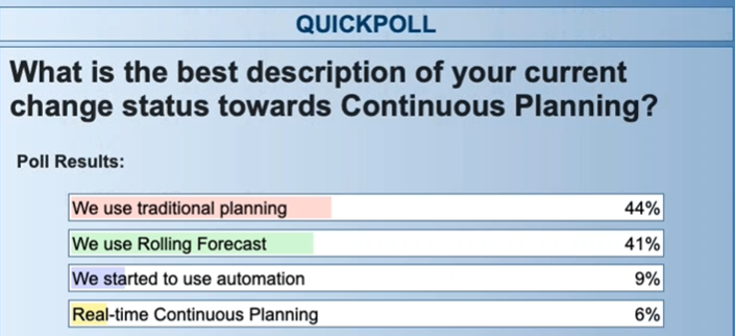This article looks at the key concepts and definitions of both integrated and agile FP&A...
 In November 2021, an FP&A Global Webinar was held on the subject of Surfing Uncertainty with Continuous Planning. The seminar was very interactive, and featured speakers from Toronto and the United States.
In November 2021, an FP&A Global Webinar was held on the subject of Surfing Uncertainty with Continuous Planning. The seminar was very interactive, and featured speakers from Toronto and the United States.
The panel comprised:
Pedro Ferreira, Global Business Intelligence Lead at Novartis
Hashim Ahmed, Chief Financial Officer at Jaguar Mining Inc.
Ben Page, Solutions Consulting Director at Planful
What Is Continuous Planning?
Continuous Planning replaces the traditional static and calendar-driven process. It is a dynamic and open-ended planning approach that responds to internal and external events as they occur. In addition, the use of technology facilitates planning agility and flexibility through real-time analytics and automation.
To be successful in continuous planning, a dynamic mindset is necessary. Compared to traditional planning, where the goal set-up process is done only once, continuous planning allows organisations to achieve more of their targets.
What Are the Requirements For Efficient Continuous Planning?
According to Pedro Ferreira, Global Business Intelligence Lead at Novartis, the three factors required for efficient continuous planning are Process, Technology, and Culture & mindset (Figure 1). Pedro stated that organisations must focus only on those processes that matter, along with the proper feedback. At the same time, technology must be used at the optimal level to support the planning process.

Figure 1
Culture & mindset can be effective if politics are kept out of it, and negotiating your outcomes would not be recommended. Instead, you must identify the action mindset that will trigger the right discussion.
Cautions:
Continuing his discussion, Pedro also emphasised the need for continuous planning to be fit for the purpose. If it is not managed correctly, it will add complexity, such as by consuming time and resources. (Figure 2)

Figure 2
Steps to start continuous planning:
Understand the requirements
Start simple, with low variables
Quick visibility to stakeholders
Get support from senior management
At the webinar, the first poll was conducted to see the challenges organisations face in continuous planning implementation. It was found that half of the participants were hindered by Mindset, while almost all other factors were equal. (Figure 3)

Figure 3
Jaguar Mining Experience: Continuous Planning for Capital Intensive Business
Hashim Ahmed, CEO of Jaguar Mining, shared his practical experience, finding that 30% of management’s time is consumed when convention planning is performed. Meanwhile, 9 out of 10 professionals find it cumbersome, and are not able to relate it.
To make their planning processes more useful and more value-adding, Jaguar Mining have used a particular approach to continuous planning. According to this approach, continuous planning is neither a Rolling Forecast, nor a periodic update. Instead, it is an automatic update without human intervention at all.
The Jaguar Mining case study revealed the following critical success factors for continuous planning:
Financial close process
Data Digitisation
Artificial Intelligence
Challenges in Continuous Planning
Of course, every process involves challenges, and continuous planning is no exception. The Harvard Business Review has found that the biggest barrier is people’s mindset, with 9 out of 10 surveyed professionals finding the process unrelatable. Having a live update on a real-time basis can be a challenging concept. Conquering that mindset is, therefore, the crucial first step for continuous planning to succeed.
The other two main challenges were the technology and the process. It turned out that to have continuous planning for a particular process, the technology should be customised. There must also be parameters that are pre-defined in discussion with the board.
The second poll was conducted to pinpoint where the participants’ organisations were on their continuous planning journey (Figure 4). It turned out that the majority are still using traditional planning and Rolling Forecasts, and the proportion using a real-time continuous approach was very low. This is perhaps attributable to the mindset challenges identified by the Harvard Business Review.

Figure 4
How Technology Can Enhance the Process
Ben Page, Solutions Consulting Director at Planful, discussed the role of technology in optimising continuous planning.
Ben mentioned that an organisation must start back closing its books. According to Ben, the actual data feeds the ability to see trending. But technology is not the only answer, because a system is not likely to be immediately ready for Continuous planning or Rolling Forecasts. An analysis of your current process is necessary to determine whether your technology is up to the task.
Ben emphasised the need to consider progress over perfection. Organisations should use a phase-wise approach for quick, successful results. Technology can also support continuous planning by automating the process, as with Driver Based Planning. Non-value-added work should be eliminated, and the primary focus should be on continuous learning.
What Are the Pre-Requisites of Technology?
According to Ben, successful technology fulfils the following criteria:
Technology as per needs: This is one of the most significant factors to look out for. It is vital to have the correct technology for the required purpose. As mentioned by Hashim, 9 out of 10 professionals could not relate to the process.
Flexibility: The only thing certain in the business environment is change, which can produce both favourable and unfavourable new outcomes. Organisations must have the appropriate technology to tackle dynamic business change, and the proper continuous planning in place.
Consider future needs: As mentioned above, technology should be fit for the purpose. Proper planning, reporting, and consolidations are equally important to the success of any process. In other words, technology should be focused on as per future requirements.
In the webinar, Ben also mentioned some of the key people involved in ensuring continuous planning success:
The technology person: Whether on your premises or in the cloud, they must be connected at all times, because technological needs could arise at any point in time.
Business partner with guidance: They should provide support over the long term, and build a strong roadmap for future needs.
A partner that will support your needs: They must have strong industry knowledge with a global presence to support the business.
Next, the case study of Steinway Musical Instruments, Inc. was presented. Steinway transitioned from traditional to more continuous planning, using technology to support their business cases. The results are very promising: they have reduced the time spent on the monthly planning process from about 8 hours to around 15 minutes. This all happened because of automation. The amount of work is the same, but the goals have changed. Steinway have attained more value-added work, and less non-value-added work. This case study demonstrates the power of technology as an enabler in continuous planning implementation. That said, the key is to focus on the process and then identify the technology that would facilitate it.
Conclusion
Continuous planning is a powerful tool for organisations, and the first step towards implementing it is fostering a supportive Mindset. Technology also plays a vital role, but organisations need to ensure they are only adopting the specific tools that are fit for the purpose. This requires first understanding their current planning process and its key drivers. The key is to start simple.
The webinar was proudly sponsored by Planful.
Subscribe to
FP&A Trends Digest

We will regularly update you on the latest trends and developments in FP&A. Take the opportunity to have articles written by finance thought leaders delivered directly to your inbox; watch compelling webinars; connect with like-minded professionals; and become a part of our global community.




